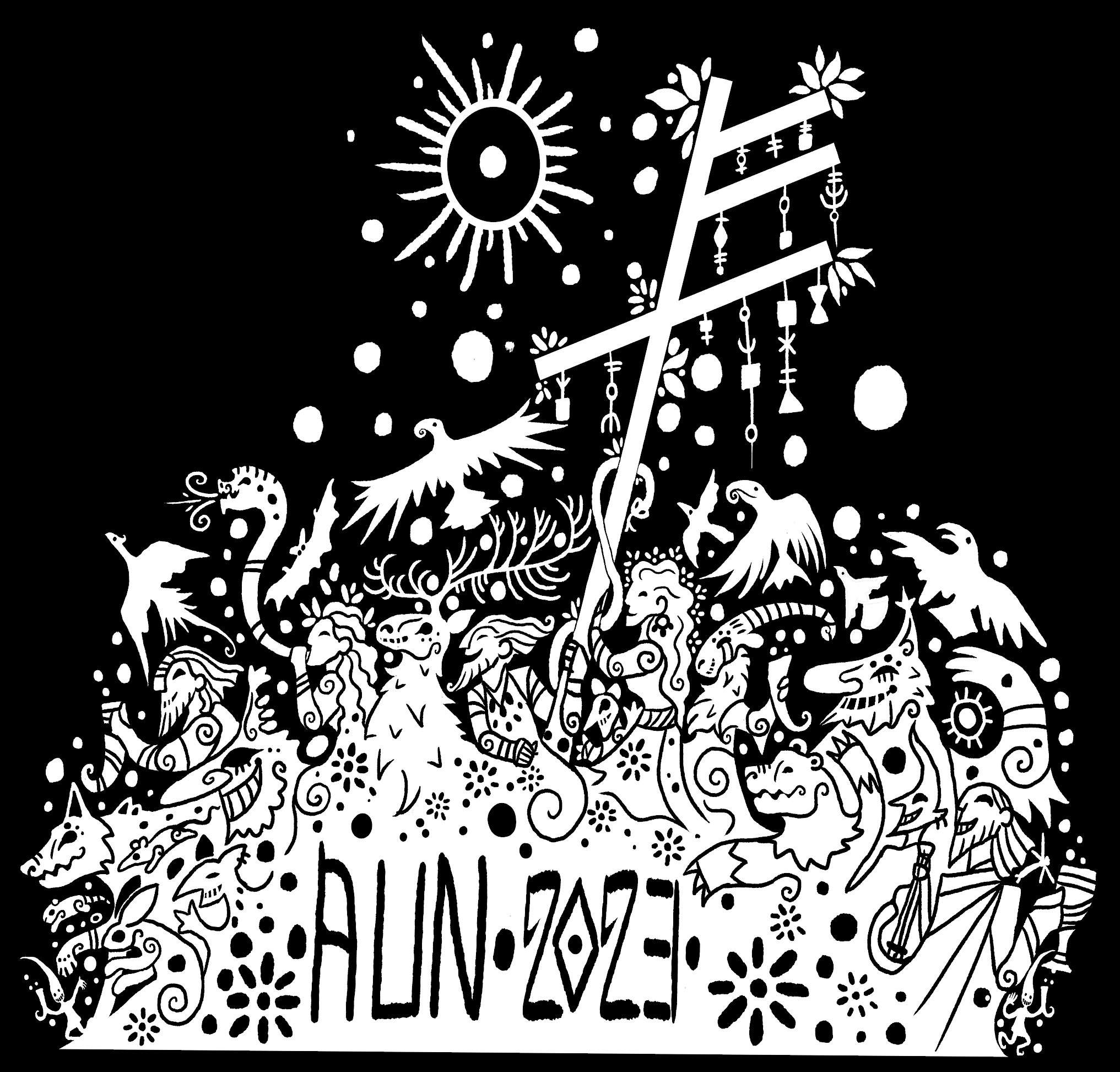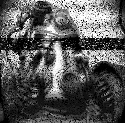|
The Ynglingsaga describes Odin as a king who came from Asia as well, and then became worshipped as a god by the Scandinavians he conquered. Snorri’s preface to his Edda tries to connect the newly Europeanized Scandinavia to the cultural heritage of the other large kingdoms by claiming that the aesir were Trojans who fled the fall of Troy. Saxo tried to make Odin a Byzantine emperor that left Byzantium after Frigg had an affair with his brothers in History of the Danes. It’s really interesting how committed medieval Scandinavians were to incorporating their heathen mythology into their still fairly new Christian society. It’s also infuriating that essentially ALL of our written sources come from people trying to remix the old beliefs into being acceptable in a medieval catholic context.
|
|
|
|

|
| # ? Jul 27, 2024 05:23 |
|
I'm back! Lots of poo poo happening in my private life, and so I might not have posted as much here as I wanted. However, I have a treat for you: The neo-heathen tradition of Long Night happened recently, and yours truly took part! A new new old thing is happening worldwide, and seems to be inspired by pre-christian traditions happening around the same time: In December, heathens, carnival-freaks, witches and other touchers of myth gather in public spaces to dress up as demons, goddesses and monsters, carrying torches and lanterns to herald the return of light to the world! The "roots" We know for a fact that pre-christian peoples had a thing for heralding the return of the light. The winter solstice and jól-celebrations both involved fires and praising the sun and sun deities to return from the dead of winter to the world. Moreover, civic celebrations by said pagans involved dressing up as monsters of the night! For some reason, the dark things and monsters had to be the ones carrying light into town. We can't know a lot for certain, but if we look at the traditions that have survived christianity, there are a lot of funky remnants. My girlfriend is Austrian, and in her homeland( as well as Germany, it apparently originates from Bavaria) this tradition is known as "Krampus Night", after the demon Krampus who shows up to scare townsfolk with their antics and terrorize children who have been naughty! It is a racous celebration, and it is not uncommon for riot police in larger places like Wien and Salzburg, to have to eject crowds of drunken disorderly demons from public squares! Arguments tend to break out since the Krampusse figures often hit people with whips, leading to retaliatory attacks, and one such scrum left 8 people treated for broken bones after a Krampus night in Tyrol in 2013! Anyway, because of this tradition, some of the places that have begun to reenact this tradition call it Krampus run. An example can be found at the Whitby Krampus Run: https://www.facebook.com/groups/1542852149315718 Other myths that are connected to this are the goddess Lusse ("light") whose cult was displaced by that of St. Lucia in Scandinavia. In my native Denmark, the feast of St. Lucia is also held high (to the point where school kids have to do a Lucia walk with lit candle crowns on their heads), and some scholars think this is because of the need to suppress an indigenous light cult that held sway before christianity. Another relevant story is that of the Wild Hunt, where a variety of undead and beasts rode out in winter nights together with the Lord of the Hunt, who in some places is a headless knight, others a faery or boggan, and in our neck of the woods have been said to be Odin Hroptatýr or Jólnar, aspects of Odin as carrion lord of the undead, or a dark yuletide figure who carries back the light. For more on the myths and ideas connected to nordic animism leading into the re-enactment of the Long Night, see Rune Hjarnřs youtube channel. He's a PHD in religion, nordic heathen and the driving force behind the Long Night recon event in Denmark: https://www.youtube.com/@NordicAnimism . Fair warning: His funen accent is extremely grinding to some ears, but he is the real deal. The night in Copenhagen For a full length stream, check this out: This guy built a camera and his smartphone rig into a huge skull staff: https://m.twitch.tv/videos/1681523976 (He spends an hour getting to the run, so you can fast forward that far) I went as a horned god figure, nodding both to Krampus himself and to the Horned Man of celtic and germanic myth. Fun fact: the mask with antlers is one I fashioned for our blót guild, to use in autumn and winter ceremonies of self-improvement - I just slapped a new cloth mask and some latex prosthesis on to go with it! I recall some of yous wanting to see the ritual suit and mask I built for one of our winter blóts, and this is it. My date was a huge antropomorphic moth, as is custom  We must have been at least 500 demons and goddesses and whatnot, walking down Strřget, which is the largest shopping thoroughfare in Copenhagen (the capital of Denmark), and a lot of folks just dropped their jaws and café lattes at the spectacle! We brought a drum corps, a troupe of fusion dancers and all manner of freaks and demons. It was glorious! At one point, someone initiated a rendition of "Kom Alle Vćsner" (lit. "Come/Call All Beings, a heathen folk classic in Denmark, basically a call on the spirits of the land and the earth goddess to hear your songs: https://www.youtube.com/watch?v=uujU3jFczoA and a lot of folks danced and sang it. At many points folks came up and asked me what the hell was going on, and when I compressed all of the above into talking points, they were mostly very grateful and interested! The high point for me, I think, was an old Inuit woman passing by, looking at my mask and said "Are you going to do the Dance of the Mask?". Having enough of an animist understanding to appreciate what she meant, I answered in the affirmative. She took my shoulder and smiled, said 'thanks' and went on her way. Needless to say, I was very moved at this cross-cultural knowledge of invoking the spirits. I'll see if I can find more pictures, more later!
|
|
|
|
That's really cool! Quite likely you've seen it, but if not you might find Charles Fréger's Wilder Mann photo series interesting: https://www.charlesfreger.com/portfolio/wilder-mann-fr/ He documents Krampus and similar ritual/festive costumes from all over Europe, really interesting to see the common elements in figures from across the continent.
|
|
|
|
I think I've come across some of them on clickbaity photo articles, but not in one place. Thanks a lot!
|
|
|
|
No problem. Glad you're back posting again and hope you're doing alright. I'm always happy to see this thread back on the first page of my bookmarks.
|
|
|
|
Tias posted:I'll see if I can find more pictures, more later! Thanks for posting this!
|
|
|
|
Good stuff! I'm quite interested in whatever information might be around about the pre-Christian cultural practices, so this is greatly appreciated The St Lucia's connection is a nice one.
|
|
|
|
|
I mean, St. Lucy's story is pretty baller, right? Here's the way it was told to me: Carrying loaves of bread, garum and oil in her arms, and having to tie candles to her head, to find her way through some dimly lit catacombs. She attempts not to cry out when the molten wax drops on her skin, so as to not alert Roman guards who'd kill her for helping people hiding from the Diocletian purges. Some say the folks she helped were gnostics, too. It's all pretty neat. However, she was shoehorned pretty blatantly over the old light festials and wild hunts of Scandinavia, heralding the long night in her own saintly fashion.
|
|
|
|
Picture grab bag from the Long Night:     Here we see a wealth of interesting mythic figures, along with some grade-A goddesses, on the left is Sáráhkká, sámi goddess of the fireplace! I particularly dig the Stream Man, with a waterlily on top of his head! E: Also note Copenhagens historic Tivoli gardens and the Danish headquarters of the industrial lobbies behind us. Our intent was to throw a festival in the heart of normality and darkness, and we did it! Tias fucked around with this message at 12:00 on Jan 5, 2023 |
|
|
|
Here are some more:  (Notice this person on the left, who off-mask is quite famous, dressed inspired by the famous ancient cave art "the sorceror": https://en.wikipedia.org/wiki/The_Sorcerer_(cave_art) which is thought to be the first ever depiction of a shaman or possibly even a deity! )   
|
|
|
|
A wee effort post on christianized folk paganism (or pagan-originating folk catholicism, I suppose!) incoming..
|
|
|
|
Wassailing This tradition, which may be as old as the early middle ages, involve folks going either house-to-house, and demanding stuff from rich people while dressed up as wild animals, herd animals or even pagan figures. In some cases, this was as benign as the wassailers singing a cute song about how they should have some fig pudding or whatever, and the lord graciously agreeing, they thank him and go on their way. More often, though, we're in "gangs of youth stationed outside to rob a fool" territory! A lord refusing to participate would often be cursed, which, uh, isn't christian. In fact, it is very clearly of pagan origin, with the apple liquour in the wassail bowl and the horned figures coming out in the darkest parts of winter singing threatening songs. If that's not enough, there's a variant called the "orchard wassail", where songs where sung to an apple orchard, and bread soaked in beer were placed in the branches along with colourful ribbons (decorating trees like this is pagan custom in most of the world, honouring the tree as an equal or elder), so it would become more fertile next year. I mean, come on Mardi Gras Mardi Gras ("fat tuesday") is celebrated in most of the french speaking world, including most famously the formerly french colony state of Lousiana and city New Orleans. My father is a blues musician who visited all of Louisiana, and told me a lot of these things. The cajuns/arcadians can be roughly split into "boat cajuns" and "horse cajuns", and the horse cajuns have an amazingly Wild Hunt-esque tradition known as Courir de la Mardi Gras (my french is super bad, but this roughly means "mardi gras ride/riding trip". It involves wassailing from farm to farm, wearing messed up swamp thing costumes and falling on your knees to beg for food to put in your gumbo pot. Normally this ends with the dude throwing the participants a chicken they then have to run after and catch. A great deal of drinking and playing of instruments is involved, and I would be remiss if I didn't include Steve Rileys amazing version of the classic courir song "Danse de La Mardi Gras": https://www.youtube.com/watch?v=KCBn9UYqhp4 Inside New Orleans, of course, this takes the form of a truly awesome parade, with everyone dressing up in carnival regalia, searching for artifacts thrown from the floats and getting super smashed and often looking for trouble, sex. Here we see what I consider one of the true meanings of yule, the 'saturnalia' of twisting regular norms upside down (see 'carnivals' below). Mari Lwyd Touched upon in this thread, Mari Lwyd (Welsh, pronounced approximately "Muh-ry Lloyd") is a wassailing folk tradition from South Wales, which entails the use of an eponymous hobby horse which is made from a horse's skull mounted on a pole and carried by an individual hidden under a sackcloth. The Mari Lwyd itself consists of a horse's skull that is decorated with ribbons and affixed to a pole; to the back of the skull is attached a white sheet, which drapes down to conceal both the pole and the individual carrying this device. On occasion, the horse's head was represented not by a skull but was instead made from wood or even paper. In some instances, the horse's jaw was able to open and close as a result of string or lever attached to it, and there are accounts of pieces of glass being affixed into the eye sockets of some examples, representing eyes! This has become a particular favourite of the internets, and the wassailing part of Mari Lwyd where you have to rap battle the ghost skeleton horse to keep your booze is well documented. Krampus ibid: Tias posted:So, the Danish and British "Krampus Runs" have been cancelled on account of COVID-19, and I figure that's a good as time as any to talk about the heathen roots of the Krampus run and Saint Lucia's day! Other yule carnivals There's a lot of crazy saturnalia-influenced carnivals out there, like the Lord of Misrule, and Feast of the Walnuts. All of them (as well, I might add, as Wild Hunts, Mardi Gras and Wassailing) involve crossdressing, which also seems to be an older element, probably related to fertility festivals.
|
|
|
|
Brace yourselves, it's time for another "new" heathen event.. THE YEAR OF AUN  Here's the intro from the group that hosts this event, which is worldwide in scope but will probably be celebrated most intensely in Europe and the US. It's a little verbose, but gives a very good idea of how heathens today try to connect the problems of today (especially climate collapse) with what we know of ancient practices: quote:Nordic Year of Cultural Healing. This is clearly from the liberal and even red-green sectors of heathenry (what we ourselves usually refer to as "inclusive heathenry" to distinguish ourselves from the blood and bacon types), and so it comes with built in criticism of capitalism and consumerism, which is also, to me, aspects of the spiritual crisis hitting us as a natural consequence of the material crisis hitting the earth goddesses. That this comes out of the pen of Rune Hjarnř (who also organized the Longnight) is clear as well, as we see a very direct parallel between the religious myth of Aun and the concrete kinship between us and the earth as seen in animism and shamanism.
|
|
|
|
sounds cool, keep us updated I'm overdue a trip to Uppsala and would have loved to schedule it to coincide with an event but *waves at everything* pandemics, ya know?
|
|
|
|
|
Sure! I don't think many heathen things goes on at old Uppsala any more, but I can ask around if you're interested.
|
|
|
Tias posted:Sure! I don't think many heathen things goes on at old Uppsala any more, but I can ask around if you're interested. I've seen footage of Midsommar bonfires there in recent years, seems to be at least some remnant cultural memories
|
|
|
|
|
Oh for sure, but (and there's always a but these days What we know: The undivided Christian Church designated June 24 as the feast day of the early Christian martyr St John the Baptist, and the observance of St John's Day begins the evening before, known as Saint John's Eve. Freemasons celebrate it as well for some reason! In Sweden, the Midsummer is such an important festivity that there have been proposals to make the Midsummer's Eve the National Day of Sweden, instead of June 6. In Finland, Estonia, Latvia and Lithuania, Midsummer's festival is a public holiday. In (my native) Denmark and Norway, it may also be referred to as St. Hans Day. The 13th-century monk of Winchcomb, Gloucestershire, who compiled a book of sermons for Christian feast days, recorded how St. John's Eve was celebrated in his time: quote:Let us speak of the revels which are accustomed to be made on St. John's Eve, of which there are three kinds. On St. John's Eve in certain regions the boys collect bones and certain other rubbish, and burn them, and therefrom a smoke is produced on the air. They also make brands and go about the fields with the brands. Thirdly, the wheel which they roll. Saint John's Fires, explained the monk of Winchcombe, were to drive away dragons, which were abroad on St. John's Eve, poisoning springs and wells. The wheel that was rolled downhill he gave its explanation: "The wheel is rolled to signify that the sun then rises to the highest point of its circle and at once turns back; thence it comes that the wheel is rolled." Of course, as we've already dived into, Midsummer is a much older pagan celebration in every european country. Examples could be (wiki articles linked where existing): Estonian Jaanipäev: https://en.wikipedia.org/wiki/Jaanip%C3%A4ev Finnish Ukon juhla: "Ukons Party", named after their god of Thunder. Even after it was converted to juhannus juhla, huges bonfires are lit, and young women perform magic rituals to learn who their coming husbands will be, and branhces of the silver birch is hung on houses. The French Fete de la St. John: Clearly a strong catholic version, but for some reason folks still light huge bonfires in the countryside.. Greek Κλήδονας: While subsumed by the eastern orthodox church, the name of this week-long festival literally means "sign" or "oracle", and it is still customary to perform spells to tell you who your husband or wife will be. Wreaths put up on doors in May are thrown on bonfires, and people jump over them, which is definitely a pre-christian habit. Polish: Noc Świętojańska: Especially in northern Poland – the Eastern Pomeranian and Kashubian regions – midsummer is celebrated on 21 or 22 June as "St. Johns Night". Girls throw wreaths made of flowers and candles into the Baltic Sea, and into lakes or rivers. The midsummer day celebration starts at about 8:00 p.m. and lasts all night until sunrise. In someplaces it is known as Kupala, and bonfires here (in the south of Poland) used to be common. It is also where people will go looking for the "flower of the fern" (and since ferns don't have flowers, the inference here is you need some magic).
|
|
|
|
quote:…every eight years, pre-Christian Scandinavians congregated in large numbers at … was supposed to align people with “those who dwell beneath the earth and ensure their forgiveness for any misdeeds * The land would rest (crop rotation) and what grows naturally must be shared and cannot be sold. * Debts (of Hebrews) are forgiven, and (Hebrew) slaves / prisoners are freed. Do we know if there was any similar ‘social reset’ in Scandinavia in these 8-year cycles? It sure seems like that kind of arraignment could really stabilize a society, IMO it would sure help the USA about now.
|
|
|
|
Well, the year of Aun seems to be some kind of 'reset' of at least the bonds of obligation between man and 'earth' (spirits, gods, and the natural world in general). There's a lot of talk about a new find of gold that places worship of Odin further back than originally thought, and I'm digging into it now to make an effort post soon.
|
|
|
Tias posted:Well, the year of Aun seems to be some kind of 'reset' of at least the bonds of obligation between man and 'earth' (spirits, gods, and the natural world in general). yeah iirc it was this https://www.ctvnews.ca/sci-tech/oldest-reference-to-norse-god-odin-found-in-danish-treasure-1.6304043 Which struck me as odd because that places Odin worship like 150-200 years before the Christian conversion (iirc like 800 in Sweden)
|
|
|
|
|
5th century is the 400s, so more like 300-400 years before.
|
|
|
|
I add gud Still a short time span really I would have expected much earlier evidence
|
|
|
|
|
Inspired by the Religoon threads discussion of soul components in classic kemetic religion, I give you: The parts of the soul in classic nordic paganism (with the usual academic caveat: We know very little, and what we know is filtered through non-primary sources (gotta make that a disclaimer: This is not an authoritative article on the 'northern soul', and makes no claim to present a unified or even cohesive view of such a concept. The northern pagans, then as today, place no real value on unified practice, and so neither can I, even if I desired to.) Iron age peoples probably did not have as firmly defined ideas of self as we do today, so keep in mind that the social self is part you, part your tribe and part everything else (the animals, trees and rocks you also share kinship with, for example). I have heard the old nordic self described well as a "locus of will, perception and spirit, but not a monad. In short, more a strong tendency than an absolute, that readily related to and thought of as a single thing in addition to its various constituent parts and a member of a group"* - but today we're talking about the inner self, both spiritual and mental. The self is composed of numerous different parts, all of which are actually semi-autonomous, and can even detach from one another! None of these parts correspond directly to the christian idea of a soul, and the norse word for the soul, sál, came about only after the norse peoples were christianized. However, some parts of the self might live on after death or do various non-self things when you sleep or die, so it's not like there can be no comparison. I'll probably talk more about it when I post about nordic ideas of afterlife again. This all sounds vague, so I'll get to the meat of the matter, the four parts of the self that we know about! The Hamr (lit. "shape" or "form") Hamr (pronounced like the English word “hammer”, only with one less m, I feel like) literally translates to “shape” or “skin.” The hamr is your "form" as in appearance, that which others perceive through sensory observation. Unlike today, though, people likely didn't think that what they perceived was absolutely correct and static/fixed. In fact, hamr is the key word or concept in the old nordic "lexicon of shapeshifting". The old norse phrase that describes the process of shapeshifting is skipta hömum, “changing hamr,” and the quality of being able to perform this feat is called hamramr, “of strong hamr.” The Hugr (can be most satisfactorily called the "mind" or "thought") The hugr corresponds to someone’s personality and conscious thoughts, and therefore overlaps considerably with what we today would call someone’s “inner self.” The hugr generally stays within its “owner,” but can at times create effects in faraway people just by thinking about them in a certain way. This is particularly possible for people who in the sources are said to have a strong hugr. The Fylgja (literally "follower", though this isn't a good English term for reasons I'll explain) This is often likened to a 'familiar', like the black cats and warty frogs of european witchcraft fame. The same animals are probably inspired at least in part by these 'creatures' (soul-parts), who in the singular are called fylgja (pron. "FILG-yah"), and fylgjur ("FILG-yur") in the plural, in old norse. The fylgje generally looks like an animal to those who have second sight, and are able to see this part of a persons self. For this reason, it could also be thought of as a 'power animal' in the native American sense, for the fylgje can likely lend the powers of the animal it represents to its owner. However, fylgjur in human appearance are not unheard of, and here some think they represent human ancestors of the owner. While it means 'follower', the fylgja is actually known for arriving before its owner in a lot of cases, such as your fylgja appearing in the dreams of people who are going to meet you soon. It's also not uncommon for your fylgja to arrive at your home before you, and fwiw old people in Iceland and Norway still speak about doors opening and stairs clattering hours before another family member comes home as if it is a naturally occurring phenomenon. Interestingly, the world fylgja is also used literally as the word for the placenta, but it doesn't appear to be connected to the self-part. The Hamingja (translatable to "luck" or "fortune", but kinda means more) The Hamingja (pron. "HAM-ing-yah") is the luck you have with you, though we should stop and consider here that the old norse concept of luck is different from our own. Here I quote again, from Bettina Sommer: “luck was a quality inherent in the man and his lineage, a part of his personality similar to his strength, intelligence, or skill with weapons, at once both the cause and the expression of the success, wealth, and power of a family.”. A good example might be Leif "the Lucky" Eiriksson, the dude who came to north America. His nickname, the Lucky, refers to his powerful Hamingja, and a better English translation would really be "the blessed", for it means someone with a great deal of personal power and ability. However, it’s not just how lucky you or your family is. It kinda radiates out from its owner, and the hamingja of a king (which must already be gently caress-off huge because he got to be king) makes sure that that powerful things happen for the realm as well. His ability to move hundreds of men and their equipment, and travel from one end of the realm to the other to hold court, isn’t seen as temporal or material power, but a spiritual-magical one as well. The hamingja, as Luck, is a part of the self, but can also be split off from you in certain circumstances! For instance, when your die, your hamingja might “reincarnate” into one of your descendants, particularly if the child is named after you, the original owner. Other times, as in Viga-Glums Saga, the hamingja just kinda decides to bequeath itself to someone else being born, without any special naming going on. The hamingja can also be lent to others, particularly if they are going on a very dangerous errand, say a life-threatening one where luck is badly needed. Tias fucked around with this message at 14:50 on Aug 11, 2023 |
|
|
|
Very interesting, thank you, tias
|
|
|
|
Love all of that, thank you Tias! I am really fascinated by both the fylgja and hamingja concepts. The idea of the former is just delightful as someone who has always had a strong bond with non-human people (bet you can't guess which species the most); and the latter has a lot of personal resonance as well, born from lived experience. I assume I am not the only person who has ever mentally mocked up a real life "character sheet" for themselves. I have long privately maintained my character sheet would have a trait where my natural luck stat was loving garbage for the first period of my life, and then if I survived long enough it sort of levelled out, and then after that it started multiplying like wild. In relation to the metaphysics with which I am familiar, there are a number of factors contributing to this  , but "luck" as an aspect of self is a really tidy category! , but "luck" as an aspect of self is a really tidy category!Being a personal aspect that is passed through lineage also makes a lot of practical sense. Even today, we all can see it's far easier for someone with a literal great family fortune to get ahead in life than a person whose family has experienced difficulties for generations.
|
|
|
|
Tias posted:
This reminds me of the Finnish belief in "etiäinen" - a premonition of someone arriving or something happening. My mother (now in her late 60s) definitely believes in this stuff, she told me many stories about etiäinen from her childhood in a very rural part of Finland. In particular I remember a story about seeing a person waving a white cloth, which was interpreted as "someone will die soon".
|
|
|
|
That's great stuff, thanks for sharing! Can you remember if someone did die afterwards?
|
|
|
|
So the full story was that a baby had just been born in that house, and the person telling the story saw someone standing in the doorway of a house, shaking off dust from bed linen that was needed for the baby. But when they went into the house, they found out that nobody had been at the door and the linen had not been taken care of. So they decided it meant that the baby might die soon. But then soon afterwards an older male relative died instead.
|
|
|
|
That's amazing! You'll find a lot of stories like this all over scandinavia. Friend of a friend knew a guy who lived in the deep forests with a wise woman for 20 years, and he suddenly popped up to inform his niece that she was with child. She was extremely spiteful, and told him to gently caress off - because she'd been sterile for years at that point, and he shuffled off to the forests again. She later discovered she was in fact pregnant, and had the child.
|
|
|
|
So we held our moon blót in the not too distant past, and while I’m normally not at liberty to talk about how others practice heathenry in my guild, this time I was the “gode” (gothi in English, Icenlandic or old Norse), or what we normally call blót-facilitator in more modern parlance. Thus, I can freely describe how I put together the ritual and what happened. When folks first arrived, I read them our peace-hallowing document (essentially, a very flowery prose version of “don’t bear weapons, don’t treat people badly, and don’t harm the good association of the heathens present”), and explained how I was going about it. I then turned folks over to the coin-master (our elected CFO) so they could pay, and I got my expenses for the sacrifice of the day, a good riesling*, comped by the association. Like all our ceremonies, the idea is to “close the ring”, binding the powers of the four cardinal directions into a magic-religious space in which we can commune with the aesir, vanir or other powers that comprise Regin, the totality of the spiritual powers of the cosmos. In each corner is a specific power that makes sense within the context of the particular blót. Usually this is a god or goddess, though sometimes other potent forces like the Norns or a mighty jotunn would be used as well. I picked Máni (the Moon, personified) in the east. As the sun rises in the east, so does the moon. In the west I had Sol (the Sun, personified, for balance.), Freja in the south (calling upon her powers of magic and enchantment in particular) and Odin in the north (thus placing him in his aspect as a world-wanderer and magic-user as well). I elected one participant to stand “in” for the various powers in west, south and north, with me standing for Máni. These participants are known as the “world corners” and will be important in a bit. Walking sun-wise (ie clockwise), I closed the circle by calling on the powers in turn, shouting their name loudly, and adding some choice words to invite them in. That done, I said “the circle is now closed, and so cannot be broken except by animals, children or the dumb, for they do not know better.” This is when we filled peoples horns. So, while not having any strict historical or archeological basis, we use mead as a sacrament. Several members are very adept mead brewers, and supply us from their own stash. Then, the mead is poured from its 2l plastic containers through our oath ring into a clay pot, consecrating it to become a hallowed sacrament that is usable for sharing with the gods. So, the oath ring. Shaped by twisting silver into a spiraling design that becomes a closed ring, it is probably inspired by the idea of the ring shape participants gather in, and the notion of giving out arm rings in heathen times. Poorly portrayed in HBO Vikings among other places, the idea is that a king or chieftain gives out silver arm rings to people to bind them in a reciprocal relationship and also to serve his authority. I don’t know if this actually happened in history, but the concept of magical rings go way back for what it’s worth. It is also used to swear binding oaths, which I’ll get into at the end of the post. Then we had Rounds. Sometimes called Toasts or Sumbels, this is that each participant in turn says a prayer to the power we have selected (so, for this blót: Odin, Freja, Moon and Sun). There are usually more rounds as well, so this time I had one for ancestors and family, and one for a freely selected god or entity. Each person in turn says what they want to say to the chosen deity or power, then drink from the mead horn (or pour it on the ground if they, like me, don’t drink alcohol or don’t want to do it at the moment). Then there’s the hallowing of runes. At one point I called the four corners (ie. my three power representatives) into the middle, ask people to place items they want to receive divine power in the centre of the ring. Then we grasp the oath ring, and say a hallowing spell. Normally this is our own ligature of the 142nd and 143rd stanzas of the hávamal, as follows: “Runes shall ye find, very great staves, very strong staves. staves that the great burner wrote Made among Gods by Odin, among Dwarves by Dvalin, By Asvidr among Jotunn, and I myself made some.” However, it being a special moon blót I made a custom verse: “Mundilfari is he who begat Moon, and the father of the flaming Sun. The round of the heavens they take each day, to teach humans Time. Under silvern light we hallow these items. Made among Gods by Odin..” We then hold the ring in silence until everyone feels the power going into the items, then I nod and people walk back to their stations and the next round begins. A final kinda round is then held, in which I grab the oath ring, and people can take it if they want to. If they do, they say a binding oath about what they want to accomplish or work towards, which is then considered witnessed by both the gods and the humans present. It is perfectly legitimate to only say it inside your head, if you consider it a private matter. Then I walked counter-clockwise, starting with the last deity I called at the beginning, Odin, then walked around the circle to the other gods in turn. I yell out their name again, then thank them for coming, adding their energy or presence to the blót, and then the blót is over. People hug each other, thanking for holding a good sacrifice, then a fire is built and the sacrificial dinner eaten. * This was a fun buy. As we consider the deities, pixies, spirits etc. we believe in as full of character as any human we might know, I struck up a chat with the store sommelier to try to ascertain what my “friend” the Moon might like. He thought I was describing a human friend, but the distinction wasn’t important in the spiritual milieu of heathenry. He quickly explained that this was a dry wine and one of his personal favorites, and It thought the moon god might like it, so Riesling it was.
|
|
|
|
We just held the "memorial blót", which is a tradition in our group, started some ten years ago by one of our regular blót facilitators when she had to bury her teenage son. Its a very somber affair, in which we hail the powers present (this time Hel, goddess of death and the afterlife, Odin, Freja and the Norn trinity), and then spend more time delving into contacting the dead with our feelings, thoughts and prayers. This is different from your regular thoughts and prayers since we do it in the Winter Nights*, where the veil between life and death is thin and our ancestors may actually show up in response to our summons. I talked to my dead cousin, who died at 34, and asked him to stop haunting me and my family, because his untimely death broke up a lot of poo poo between myself, my parents and his parents, poo poo that unfortunately can't be adressed as long as we keep mourning him. In an interesting bit of syncretism, I asked him to try and get help from our grandparents, since he was pretty christian and believed in intercession. After that we had a good blót meal, and enjoyed the closeness of the dead. This time the blót seemed especially effective, and several of us came away with the feeling that the dead had either listened, or that the act of us telling them our problems in trust that they might understand them, helped us heal and go on with our lives. * Winter Nights was held in pre-christian scandinavia exactly 28 days after the autumn equinox, and last 3 days, known for being the "3 nights when winter starts". From Ynglingasaga, though the exact terms winter night isn't used: "There should be a sacrifice at the beginning of winter for a good year, and in the middle of winter for a good crop, the third in summer day, that was the sacrifice for victory." The term is attested in the narrative of some of the Fornaldarsögur, mostly to express passage of time ("as autumn turned into winter"). The first day of weather was believed to set the course for the rest of the winter, for example snow during the event would mean a snowy winter. It would usually be marked with a leaf-less (defoliated) tree. Scholars have proposed a connection between this event and the anglo-saxan pagan: Mōdraniht https://en.wikipedia.org/wiki/M%C5%8Ddraniht but who knows, really.
|
|
|
|
These are incredible writeups Tias, thank you so much for sharing the experiences with us.
|
|
|
|
No problem. I don't know if anything is coming up other than our yule blót and of course the Long Night runs.
|
|
|
|
I haven't posted for a while because new job is hard  However, something happened recently of great joy to the more online heathens! The founder of "NÖRSKK", a really stupid grift teaching people to be true heathen vikings by, uh, hating liberalism and going to 42 thousand dollar retreats on mountains, had it's rear end kicked in court. Among other things, he claimed to be a Norwegian, having copyrights infringed by actual heathen individuals and groups, and lying about both his name and having written several books. Since heathen belief rarely has the financial and legal resources to protect its institutions, symbols and ideas from hate groups and grifters, seeing one of the worst swindlers get kicked directly in the dick really made my day. The dispute ruling can be read here: https://onedrive.live.com/edit?id=1...d0de7db3ae9876c
|
|
|
|
who would claim to be Norwegian who isn't? Congrats Tias on the new job also nice to see you posting again!
|
|
|
|
|
Thanks! I might do an effortpost again soon, possibly to discuss the sacking of Diana Paxson, one of asatrus best known writers because of her association with child sexual abuse
|
|
|
|
Oof. Because of her connections with MZ Bradley and Breen, or something of her own?
|
|
|
|
From what I've come to understand of it, short version is that a lot of it has to do with those two, yes, but also newer conversations where it's apparent she knew what was happening and, at best, didn't say anything or, at worst, actively tried to keep what did happen from getting out. Given how much she blends her own thoughts into actual history when writing, I can't really say I'm all that surprised that she didn't see an issue with what she was/is doing. What a time to find this thread lol
|
|
|
|

|
| # ? Jul 27, 2024 05:23 |
|
A newer case has apparently come to light, a person named Sheree Rosales says she was molested in the kindred group known as Hrafnar, which was AFAIK founded and led by Paxson. Upon showing Diana diary and testimony evidence, Paxson dismissed them, and kept the abuser in charge of guarding people who were in trance states, and with her history with MZB and Breen, this is seen as particularly damning. It's a bit hard to penetrate what actually happened though, as the Troth isn't forthcoming with either reasons or evidence, they just maintain that she was sacked for not conforming to their bylaws for acceptable behaviour, which.. sure, I mean, any religious group is well within its rights to perform such an exclusion, and definitely also should if a trustee is doing bad poo poo - but between that and the many, many kids calling for her blood right now, I have a hard time figuring out what actually happened 
|
|
|

























